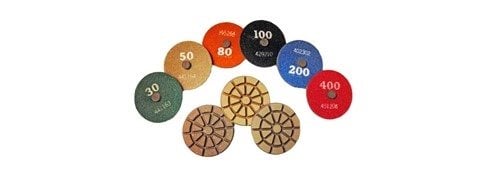Concrete Shot Blasters
How They Work
Shotblasting is a one-step method for stripping, cleaning and profiling surfaces in preparation for coatings and overlays. Not only do shotblasting systems produce a roughened texture that improves adhesion of decorative toppings, they also leave surfaces dry and immediately ready for recoating or resurfacing.
Shop for surface preparation equipment
Most shotblasters use a wheel with paddle-type blades that propel steel shot at the surface at a high velocity using centrifugal force, fracturing off the surface layer of the concrete along with any dirt, coatings, paint or other contaminants. The entire process is confined in an enclosed blast chamber that recovers and separates the dust from the spent steel shot. The removed debris is sent to a separate dust collector while the reusable abrasive is recirculated. The depth of surface removal is controlled by a combination of factors, including the size of the shot and concentration used, the rate of machine travel, shot impact force and whether you need to strip away an existing coating.
Shotblasters are typically walk-behind or ride-on units, with blasting paths ranging from 4 to 32 inches and removal rates from about 200 to over 3,000 square feet per hour. Smaller models are good for working in tight areas, such as around equipment and obstructions and next to walls, and for preparing residential garage floors or balconies for decorative coatings. The most common power options are electric, diesel and gasoline.
Typical Applications
Shotblasters can perform surface preparation tasks ranging from very light etching to more aggressive removal of surface mortar down to coarse aggregate. They also are a cost-effective method for removing dirt, grime and chemical contaminants from large areas and for prepping substrates for self-leveling or polymer overlays, epoxy toppings and most coatings. Another big advantage of shotblasting is that it produces very little airborne dust or debris, making the method a good choice for floors in sensitive areas, such as food preparation facilities or manufacturing plants.
What shotblasters can't do effectively is remove rubbery mastics or heavy elastomeric coatings, because the steel shot will just bounce off the surface.
Tips for Best Results
- The hardness of the concrete and the presence of a previous coating can affect production rates and the depth of material removal. When removing thick coatings, you may need to make multiple passes with the shotblaster or consider a more aggressive removal method, such as a scarifier.
- Shotblasters can leave "cornrows" where successive passes overlap, and these paths may be visible if you plan to cover the prepared surface with a clear coating or thin overlay. Some larger shotblasting machines have horizontally fed rather than center-fed blast wheel configurations that distribute the shot more evenly and minimize the cornrow effect.
- Smaller steel shot provides better coverage and higher production rates. Use the smallest steel shot size possible to achieve the desired results.
- If the slab has areas of softer and harder concrete, vary the travel speed of the machine to get more consistent results. A slower speed tends to remove more material.
Return to Surface Prep Buyer's Guide
 Propane Grinding Machines
Go cordless with the LAVINA elite series
Propane Grinding Machines
Go cordless with the LAVINA elite series
 Concentrated Concrete Cleaner
Clean and profile concrete in a single step
Concentrated Concrete Cleaner
Clean and profile concrete in a single step
 Surface Prep Diamonds
Superior floor with reduced steps
Surface Prep Diamonds
Superior floor with reduced steps
 CPS G-170 Electric
17" Floor Grinder 230 volt ($7,600)
CPS G-170 Electric
17" Floor Grinder 230 volt ($7,600)
 LAVINA® ELITE Vacuums
Ranging from 16" to 32"
LAVINA® ELITE Vacuums
Ranging from 16" to 32"






